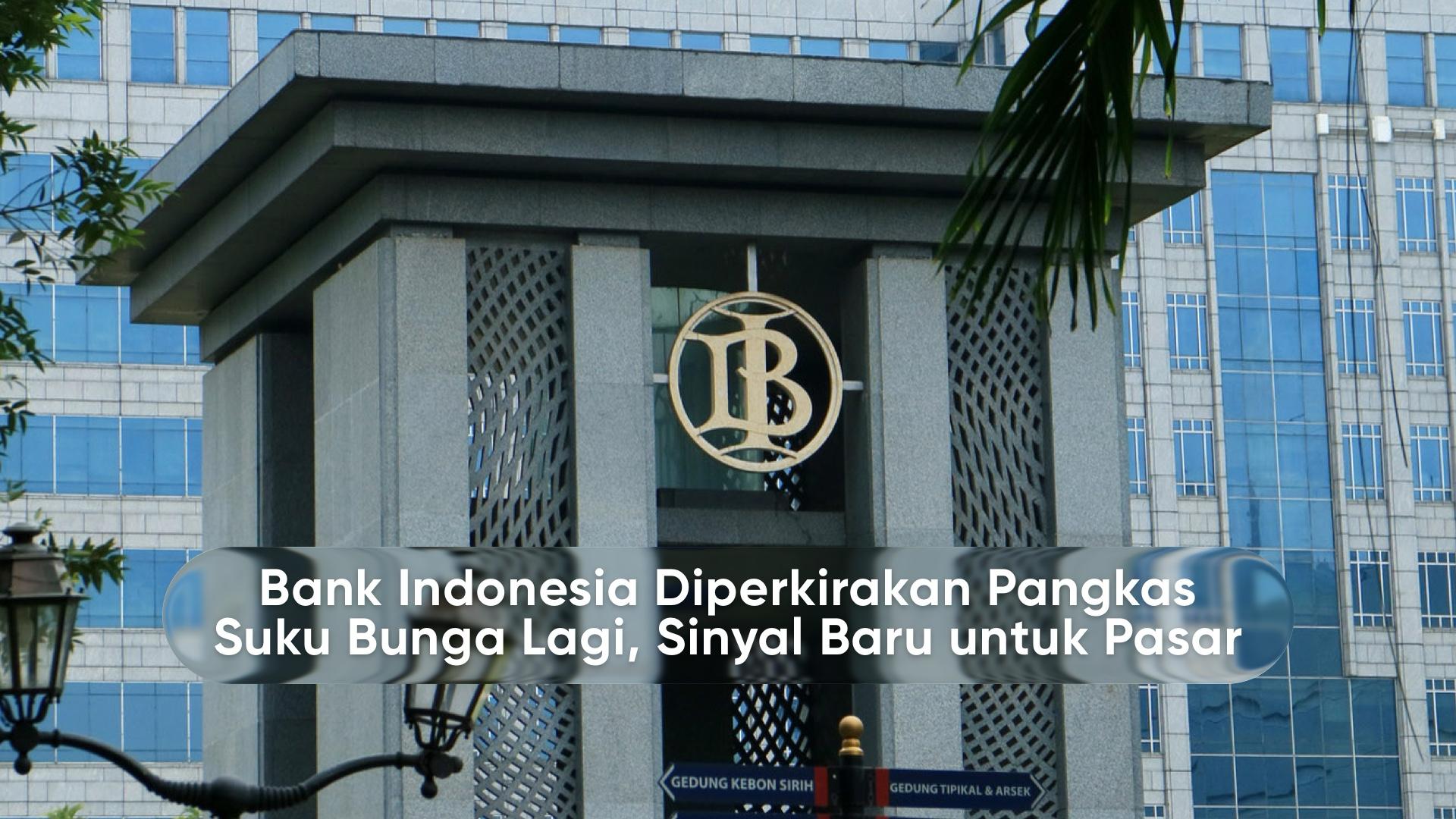Bank Indonesia (BI) diperkirakan akan kembali memangkas suku bunga acuannya dalam waktu dekat. Langkah ini diyakini sebagai strategi untuk menjaga momentum pertumbuhan ekonomi nasional di tengah tekanan global dan tren pelonggaran kebijakan moneter yang meluas di berbagai negara.
Keputusan ini akan menjadi salah satu yang paling dinantikan pasar, terutama setelah serangkaian data makroekonomi menunjukkan adanya ruang bagi pelonggaran moneter lebih lanjut. Investor dan pelaku pasar menilai, arah kebijakan BI selanjutnya akan sangat menentukan pergerakan nilai tukar rupiah, suku bunga kredit, dan prospek investasi dalam negeri.
Prospek Kebijakan Moneter Bank Indonesia
Selama beberapa bulan terakhir, BI telah menahan suku bunga acuan di level 6,00%. Namun, tanda-tanda pelonggaran mulai terlihat setelah tekanan inflasi mereda dan stabil di bawah target 3%. Bank sentral juga terus memantau arah kebijakan The Federal Reserve (The Fed) yang memberi sinyal penurunan suku bunga pada kuartal mendatang.
Menurut sejumlah ekonom, jika The Fed benar-benar menurunkan suku bunga, maka BI akan memiliki ruang lebih luas untuk menyesuaikan kebijakan tanpa menimbulkan tekanan terhadap rupiah. Skenario ini akan mendukung pembiayaan sektor riil, memperkuat kredit konsumsi, serta menstimulasi investasi domestik.
Dampak Langsung ke Pasar Keuangan
Penurunan suku bunga biasanya diikuti dengan penurunan imbal hasil obligasi dan penguatan harga saham, terutama pada sektor-sektor sensitif terhadap bunga seperti properti, perbankan, dan manufaktur. Investor lokal maupun asing akan menyesuaikan portofolionya untuk mencari peluang baru di tengah biaya pinjaman yang lebih rendah.
Selain itu, penurunan suku bunga juga bisa meningkatkan permintaan terhadap aset berisiko. Hal ini akan mendorong aliran modal asing ke pasar saham Indonesia, memperbaiki likuiditas, dan menstabilkan kurs rupiah terhadap dolar AS.
Faktor-Faktor yang Mendorong Keputusan BI
Beberapa faktor menjadi alasan utama mengapa Bank Indonesia diperkirakan akan menurunkan suku bunga lagi. Pertama, inflasi domestik yang terkendali. Data terbaru menunjukkan inflasi tahunan stabil di kisaran 2,8%, lebih rendah dari ekspektasi pasar. Kedua, pertumbuhan ekonomi yang mulai melambat akibat lemahnya ekspor dan penurunan permintaan global.
Selain itu, BI juga mempertimbangkan kondisi pasar tenaga kerja dan konsumsi rumah tangga. Dalam laporan terakhir, tingkat pengangguran terbuka sedikit meningkat, sementara indeks kepercayaan konsumen mulai menunjukkan pelemahan. Kombinasi faktor ini menjadi alasan kuat untuk menurunkan suku bunga demi menjaga daya beli masyarakat.
Korelasi dengan Stabilitas Rupiah
Meski pelonggaran moneter dapat menstimulasi ekonomi, BI tetap menghadapi dilema stabilitas nilai tukar. Rupiah yang terlalu lemah bisa memicu imported inflation dan menekan neraca perdagangan. Oleh karena itu, langkah pemangkasan suku bunga harus dilakukan secara hati-hati dan bertahap.
Dalam skenario moderat, BI diperkirakan akan menurunkan suku bunga sebesar 25 basis poin pada pertemuan berikutnya. Ini merupakan level yang dinilai cukup aman untuk menjaga keseimbangan antara dukungan terhadap pertumbuhan dan perlindungan stabilitas moneter.
Analisis Dampak ke Dunia Usaha
Pelaku usaha menyambut positif ekspektasi pemangkasan suku bunga ini. Penurunan bunga kredit akan memperingan beban pembiayaan, terutama di sektor-sektor padat modal seperti properti, konstruksi, dan industri manufaktur. Selain itu, biaya pinjaman yang lebih murah dapat meningkatkan ekspansi usaha kecil dan menengah (UKM) yang selama ini menjadi tulang punggung ekonomi nasional.
Potensi Kenaikan Permintaan Kredit
Sejumlah bank besar seperti BCA, BRI, dan Mandiri mulai memproyeksikan peningkatan permintaan kredit konsumsi dan modal kerja hingga 7% pada kuartal depan. Suku bunga yang lebih rendah akan mendorong masyarakat melakukan pembelian besar, termasuk rumah, kendaraan, dan investasi bisnis baru.
Namun, beberapa analis memperingatkan agar perbankan tetap berhati-hati terhadap potensi peningkatan risiko kredit macet, terutama jika kondisi ekonomi global belum sepenuhnya pulih.
Perspektif Global dan Dampaknya bagi Indonesia
Kebijakan moneter BI tidak bisa dilepaskan dari tren global. Saat ini, sejumlah bank sentral di Asia dan Eropa telah lebih dulu menurunkan suku bunga sebagai respons terhadap perlambatan ekonomi dunia. Langkah BI yang searah dengan tren global akan memperkuat posisi Indonesia di mata investor internasional sebagai negara dengan kebijakan moneter yang adaptif dan stabil.
Komparasi dengan Negara Lain
Sebagai contoh, Bank of Korea dan Bank Negara Malaysia telah memangkas suku bunga mereka lebih awal untuk mengantisipasi risiko perlambatan ekspor. Dengan langkah serupa, BI akan menjaga daya saing ekonomi domestik dan memperkuat fondasi pemulihan jangka menengah.
Selain itu, sinyal pelonggaran ini juga dapat memperkuat daya tarik pasar obligasi Indonesia yang masih menawarkan imbal hasil lebih tinggi dibandingkan negara-negara berkembang lainnya.
Tantangan BI dalam Menjaga Keseimbangan
Meskipun peluang pemangkasan suku bunga cukup besar, BI tetap harus menyeimbangkan antara kebutuhan mendorong pertumbuhan dan menjaga stabilitas makroekonomi. Salah satu risiko utama adalah potensi arus keluar modal asing apabila pelonggaran dianggap terlalu agresif.
Selain itu, BI juga perlu memastikan bahwa pelonggaran moneter benar-benar diterjemahkan ke dalam penurunan bunga kredit di sektor perbankan. Jika tidak, manfaat kebijakan ini akan terbatas dan tidak berdampak luas pada perekonomian.
Ekspektasi pasar terhadap langkah Bank Indonesia memangkas suku bunga kembali mencerminkan keyakinan bahwa ekonomi nasional masih memiliki ruang untuk tumbuh lebih kuat. Dengan inflasi yang terkendali, nilai tukar yang relatif stabil, dan kebutuhan mendorong konsumsi domestik, langkah pelonggaran moneter tampak menjadi pilihan rasional.
Namun, keberhasilan kebijakan ini akan sangat bergantung pada koordinasi antara bank sentral, pemerintah, dan sektor keuangan. Jika dilakukan dengan hati-hati, pemangkasan suku bunga akan menjadi katalis penting bagi pemulihan ekonomi Indonesia di tengah dinamika global yang masih penuh ketidakpastian.
Discover more from Insimen
Subscribe to get the latest posts sent to your email.





























